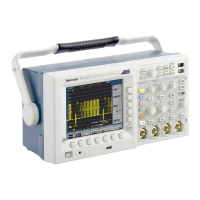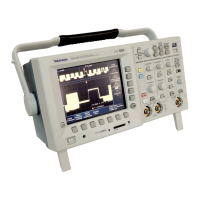

Do you have a question about the Tektronix TDS3034C and is the answer not in the manual?
| Bandwidth | 300 MHz |
|---|---|
| Channels | 4 |
| Sample Rate | 2.5 GS/s |
| Display Type | Color LCD |
| Vertical Resolution | 8 bits |
| FFT | Yes |
| Interfaces | USB, GPIB, Ethernet |
| Input Coupling | AC, DC, GND |
| Timebase Accuracy | ± 50 ppm |
| Trigger Modes | Edge, Pulse, Video, Logic |
| Maximum Input Voltage | 300 V (DC + peak AC) |
| Power Requirements | 100 to 240 VAC, 50/60 Hz |
| Memory Depth | 10, 000 points |
| Input Impedance | 1 MΩ ± 2% |
Instructions on proper grounding, power cord usage, and disconnect procedures for safety.
Guidance on safe connection, usage, and inspection of probes and test leads.
Steps for verifying oscilloscope function, compensating probes, and setting date/time.
Explanation of Run/Stop, Single Sequence, Autoset, and various acquisition modes.
How to use on-screen markers (cursors) for waveform measurements and their types.
Detailed explanation of controls for time base, position, delay, and zoom functions.
How to use math operations and Fast Fourier Transform (FFT) for signal analysis.
Overview of automatic measurements, gating, and setup options available in the Measure menu.
Instructions for saving and recalling oscilloscope setups and waveforms.
Detailed explanation of trigger types, sources, levels, and modes for signal capture.
How to adjust vertical position, scale, and input parameters for selected waveforms.
Procedures for configuring network parameters like IP address, DHCP/BOOTP.
Steps to verify network connectivity for printing and remote access.
Guidance for resolving common network problems with the oscilloscope.











